ACC203 Management Accounting: Balanced Scorecard at Qantas
VerifiedAdded on 2023/06/08
|10
|2493
|112
Case Study
AI Summary
This ACC203 assignment delves into Qantas' adoption of the balanced scorecard approach and management accounting practices (MAP) to measure performance. It examines the four perspectives of the balanced scorecard: customer, internal business, learning and innovation, and financial, highlighting their importance in understanding Qantas' strategic management. The analysis includes Qantas' critical success factors such as route management, strong leadership, non-stop flights, competent workforce, and cost utilization, alongside key performance indicators (KPIs) like customer satisfaction, brand reputation, and social media presence. The assignment further explores Qantas' strategy map, linking financial goals, customer expectations, internal processes, and learning & growth initiatives. It emphasizes the shift from traditional cost accounting to a balanced scorecard approach, showcasing the benefits of MAP implementation for both large enterprises and SMEs. Concluding with a review of Qantas' financial perspective, customer perspective, internal business perspective, and learning innovation, this case study provides a comprehensive overview of Qantas' performance management strategies.

qwertyuiopasdfghjklzxcvbnmqwerty
uiopasdfghjklzxcvbnmqwertyuiopasd
fghjklzxcvbnmqwertyuiopasdfghjklzx
cvbnmqwertyuiopasdfghjklzxcvbnmq
wertyuiopasdfghjklzxcvbnmqwertyui
opasdfghjklzxcvbnmqwertyuiopasdfg
hjklzxcvbnmqwertyuiopasdfghjklzxc
vbnmqwertyuiopasdfghjklzxcvbnmq
wertyuiopasdfghjklzxcvbnmqwertyui
opasdfghjklzxcvbnmqwertyuiopasdfg
hjklzxcvbnmqwertyuiopasdfghjklzxc
vbnmqwertyuiopasdfghjklzxcvbnmq
wertyuiopasdfghjklzxcvbnmqwertyui
opasdfghjklzxcvbnmqwertyuiopasdfg
hjklzxcvbnmrtyuiopasdfghjklzxcvbn
mqwertyuiopasdfghjklzxcvbnmqwert
yuiopasdfghjklzxcvbnmqwertyuiopas
dfghjklzxcvbnmqwertyuiopasdfghjklz
ACC203 Management Accounting
Term 2
Major Assignment
uiopasdfghjklzxcvbnmqwertyuiopasd
fghjklzxcvbnmqwertyuiopasdfghjklzx
cvbnmqwertyuiopasdfghjklzxcvbnmq
wertyuiopasdfghjklzxcvbnmqwertyui
opasdfghjklzxcvbnmqwertyuiopasdfg
hjklzxcvbnmqwertyuiopasdfghjklzxc
vbnmqwertyuiopasdfghjklzxcvbnmq
wertyuiopasdfghjklzxcvbnmqwertyui
opasdfghjklzxcvbnmqwertyuiopasdfg
hjklzxcvbnmqwertyuiopasdfghjklzxc
vbnmqwertyuiopasdfghjklzxcvbnmq
wertyuiopasdfghjklzxcvbnmqwertyui
opasdfghjklzxcvbnmqwertyuiopasdfg
hjklzxcvbnmrtyuiopasdfghjklzxcvbn
mqwertyuiopasdfghjklzxcvbnmqwert
yuiopasdfghjklzxcvbnmqwertyuiopas
dfghjklzxcvbnmqwertyuiopasdfghjklz
ACC203 Management Accounting
Term 2
Major Assignment
Paraphrase This Document
Need a fresh take? Get an instant paraphrase of this document with our AI Paraphraser
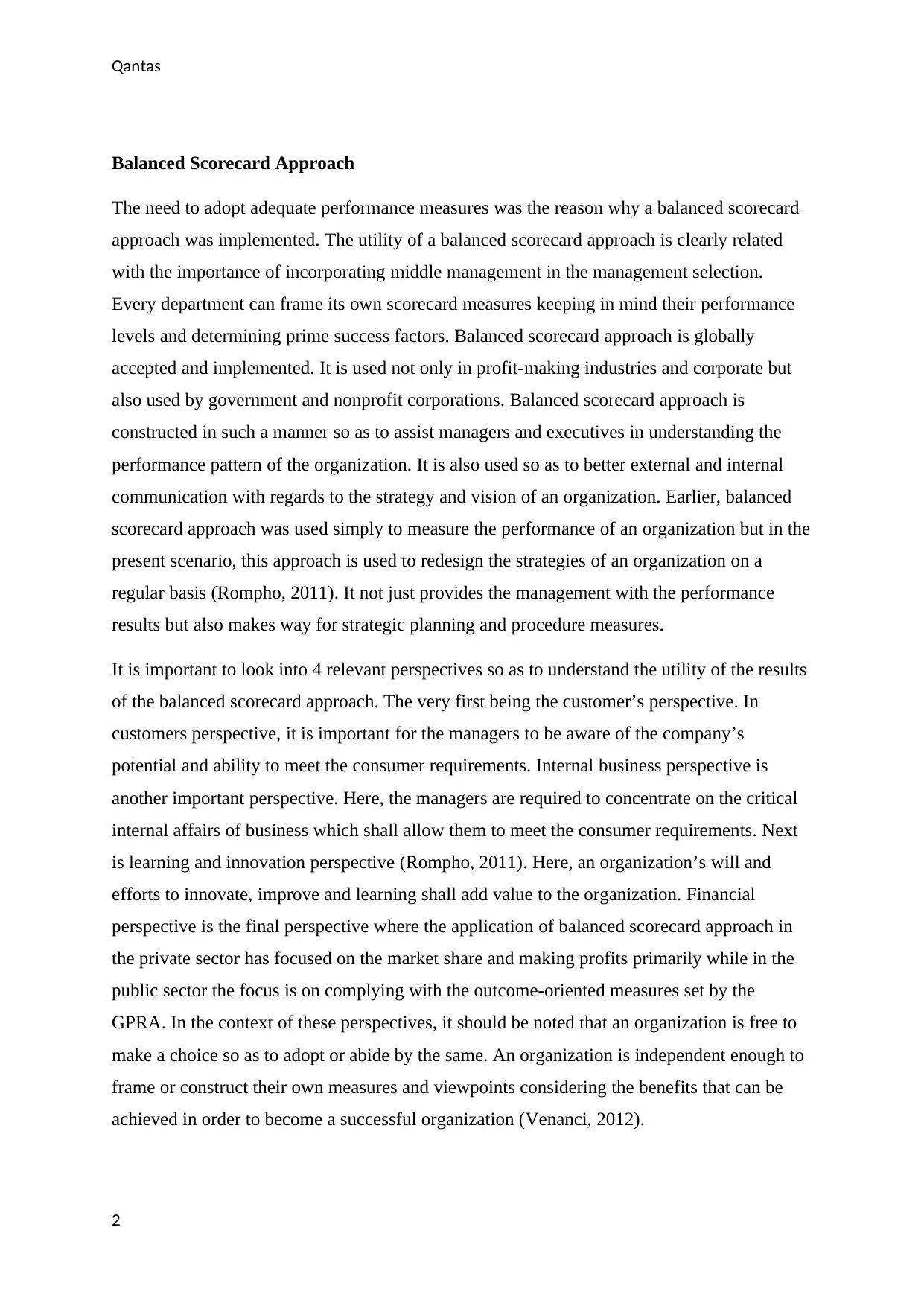
Qantas
Balanced Scorecard Approach
The need to adopt adequate performance measures was the reason why a balanced scorecard
approach was implemented. The utility of a balanced scorecard approach is clearly related
with the importance of incorporating middle management in the management selection.
Every department can frame its own scorecard measures keeping in mind their performance
levels and determining prime success factors. Balanced scorecard approach is globally
accepted and implemented. It is used not only in profit-making industries and corporate but
also used by government and nonprofit corporations. Balanced scorecard approach is
constructed in such a manner so as to assist managers and executives in understanding the
performance pattern of the organization. It is also used so as to better external and internal
communication with regards to the strategy and vision of an organization. Earlier, balanced
scorecard approach was used simply to measure the performance of an organization but in the
present scenario, this approach is used to redesign the strategies of an organization on a
regular basis (Rompho, 2011). It not just provides the management with the performance
results but also makes way for strategic planning and procedure measures.
It is important to look into 4 relevant perspectives so as to understand the utility of the results
of the balanced scorecard approach. The very first being the customer’s perspective. In
customers perspective, it is important for the managers to be aware of the company’s
potential and ability to meet the consumer requirements. Internal business perspective is
another important perspective. Here, the managers are required to concentrate on the critical
internal affairs of business which shall allow them to meet the consumer requirements. Next
is learning and innovation perspective (Rompho, 2011). Here, an organization’s will and
efforts to innovate, improve and learning shall add value to the organization. Financial
perspective is the final perspective where the application of balanced scorecard approach in
the private sector has focused on the market share and making profits primarily while in the
public sector the focus is on complying with the outcome-oriented measures set by the
GPRA. In the context of these perspectives, it should be noted that an organization is free to
make a choice so as to adopt or abide by the same. An organization is independent enough to
frame or construct their own measures and viewpoints considering the benefits that can be
achieved in order to become a successful organization (Venanci, 2012).
2
Balanced Scorecard Approach
The need to adopt adequate performance measures was the reason why a balanced scorecard
approach was implemented. The utility of a balanced scorecard approach is clearly related
with the importance of incorporating middle management in the management selection.
Every department can frame its own scorecard measures keeping in mind their performance
levels and determining prime success factors. Balanced scorecard approach is globally
accepted and implemented. It is used not only in profit-making industries and corporate but
also used by government and nonprofit corporations. Balanced scorecard approach is
constructed in such a manner so as to assist managers and executives in understanding the
performance pattern of the organization. It is also used so as to better external and internal
communication with regards to the strategy and vision of an organization. Earlier, balanced
scorecard approach was used simply to measure the performance of an organization but in the
present scenario, this approach is used to redesign the strategies of an organization on a
regular basis (Rompho, 2011). It not just provides the management with the performance
results but also makes way for strategic planning and procedure measures.
It is important to look into 4 relevant perspectives so as to understand the utility of the results
of the balanced scorecard approach. The very first being the customer’s perspective. In
customers perspective, it is important for the managers to be aware of the company’s
potential and ability to meet the consumer requirements. Internal business perspective is
another important perspective. Here, the managers are required to concentrate on the critical
internal affairs of business which shall allow them to meet the consumer requirements. Next
is learning and innovation perspective (Rompho, 2011). Here, an organization’s will and
efforts to innovate, improve and learning shall add value to the organization. Financial
perspective is the final perspective where the application of balanced scorecard approach in
the private sector has focused on the market share and making profits primarily while in the
public sector the focus is on complying with the outcome-oriented measures set by the
GPRA. In the context of these perspectives, it should be noted that an organization is free to
make a choice so as to adopt or abide by the same. An organization is independent enough to
frame or construct their own measures and viewpoints considering the benefits that can be
achieved in order to become a successful organization (Venanci, 2012).
2
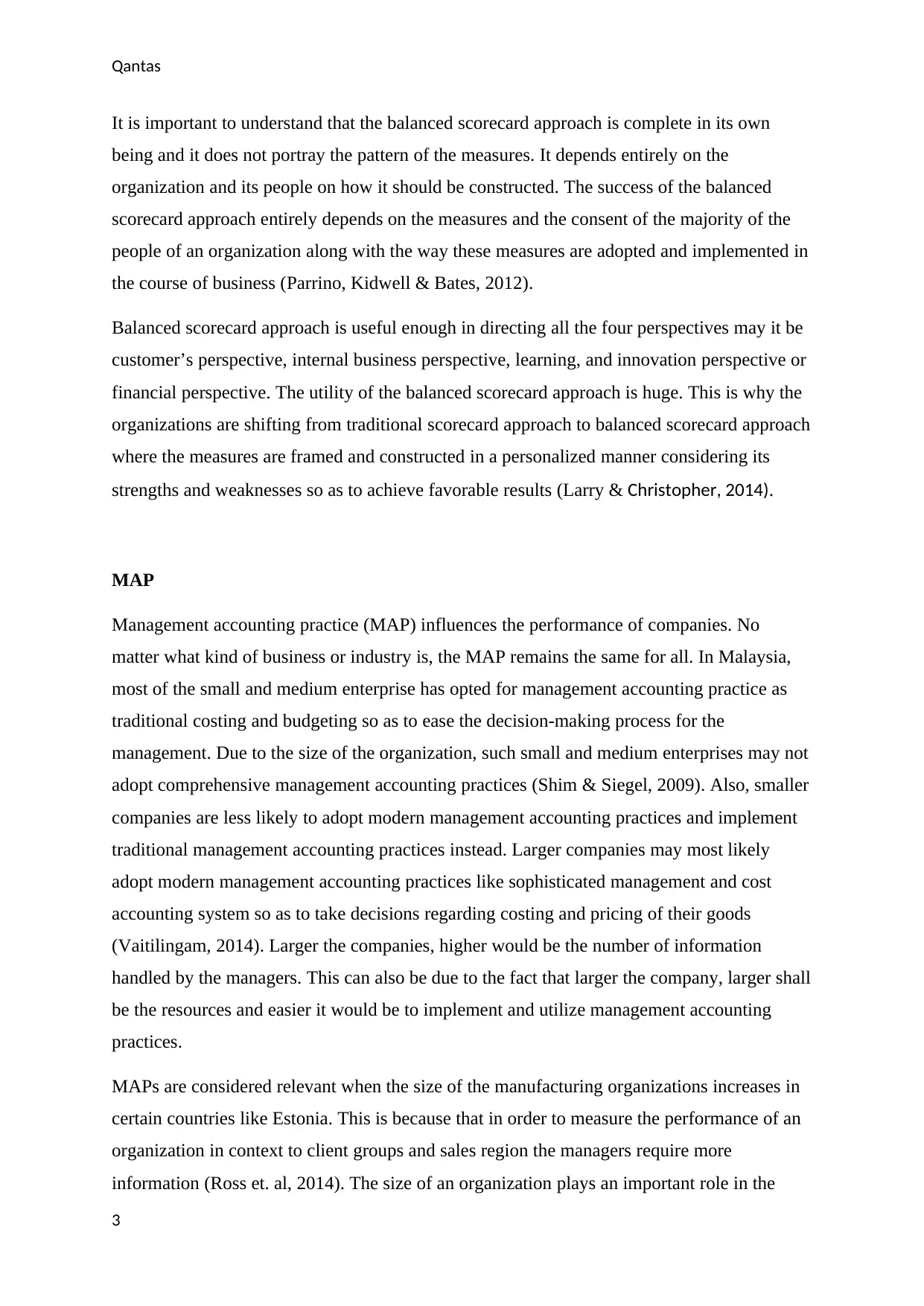
Qantas
It is important to understand that the balanced scorecard approach is complete in its own
being and it does not portray the pattern of the measures. It depends entirely on the
organization and its people on how it should be constructed. The success of the balanced
scorecard approach entirely depends on the measures and the consent of the majority of the
people of an organization along with the way these measures are adopted and implemented in
the course of business (Parrino, Kidwell & Bates, 2012).
Balanced scorecard approach is useful enough in directing all the four perspectives may it be
customer’s perspective, internal business perspective, learning, and innovation perspective or
financial perspective. The utility of the balanced scorecard approach is huge. This is why the
organizations are shifting from traditional scorecard approach to balanced scorecard approach
where the measures are framed and constructed in a personalized manner considering its
strengths and weaknesses so as to achieve favorable results (Larry & Christopher, 2014).
MAP
Management accounting practice (MAP) influences the performance of companies. No
matter what kind of business or industry is, the MAP remains the same for all. In Malaysia,
most of the small and medium enterprise has opted for management accounting practice as
traditional costing and budgeting so as to ease the decision-making process for the
management. Due to the size of the organization, such small and medium enterprises may not
adopt comprehensive management accounting practices (Shim & Siegel, 2009). Also, smaller
companies are less likely to adopt modern management accounting practices and implement
traditional management accounting practices instead. Larger companies may most likely
adopt modern management accounting practices like sophisticated management and cost
accounting system so as to take decisions regarding costing and pricing of their goods
(Vaitilingam, 2014). Larger the companies, higher would be the number of information
handled by the managers. This can also be due to the fact that larger the company, larger shall
be the resources and easier it would be to implement and utilize management accounting
practices.
MAPs are considered relevant when the size of the manufacturing organizations increases in
certain countries like Estonia. This is because that in order to measure the performance of an
organization in context to client groups and sales region the managers require more
information (Ross et. al, 2014). The size of an organization plays an important role in the
3
It is important to understand that the balanced scorecard approach is complete in its own
being and it does not portray the pattern of the measures. It depends entirely on the
organization and its people on how it should be constructed. The success of the balanced
scorecard approach entirely depends on the measures and the consent of the majority of the
people of an organization along with the way these measures are adopted and implemented in
the course of business (Parrino, Kidwell & Bates, 2012).
Balanced scorecard approach is useful enough in directing all the four perspectives may it be
customer’s perspective, internal business perspective, learning, and innovation perspective or
financial perspective. The utility of the balanced scorecard approach is huge. This is why the
organizations are shifting from traditional scorecard approach to balanced scorecard approach
where the measures are framed and constructed in a personalized manner considering its
strengths and weaknesses so as to achieve favorable results (Larry & Christopher, 2014).
MAP
Management accounting practice (MAP) influences the performance of companies. No
matter what kind of business or industry is, the MAP remains the same for all. In Malaysia,
most of the small and medium enterprise has opted for management accounting practice as
traditional costing and budgeting so as to ease the decision-making process for the
management. Due to the size of the organization, such small and medium enterprises may not
adopt comprehensive management accounting practices (Shim & Siegel, 2009). Also, smaller
companies are less likely to adopt modern management accounting practices and implement
traditional management accounting practices instead. Larger companies may most likely
adopt modern management accounting practices like sophisticated management and cost
accounting system so as to take decisions regarding costing and pricing of their goods
(Vaitilingam, 2014). Larger the companies, higher would be the number of information
handled by the managers. This can also be due to the fact that larger the company, larger shall
be the resources and easier it would be to implement and utilize management accounting
practices.
MAPs are considered relevant when the size of the manufacturing organizations increases in
certain countries like Estonia. This is because that in order to measure the performance of an
organization in context to client groups and sales region the managers require more
information (Ross et. al, 2014). The size of an organization plays an important role in the
3
⊘ This is a preview!⊘
Do you want full access?
Subscribe today to unlock all pages.

Trusted by 1+ million students worldwide
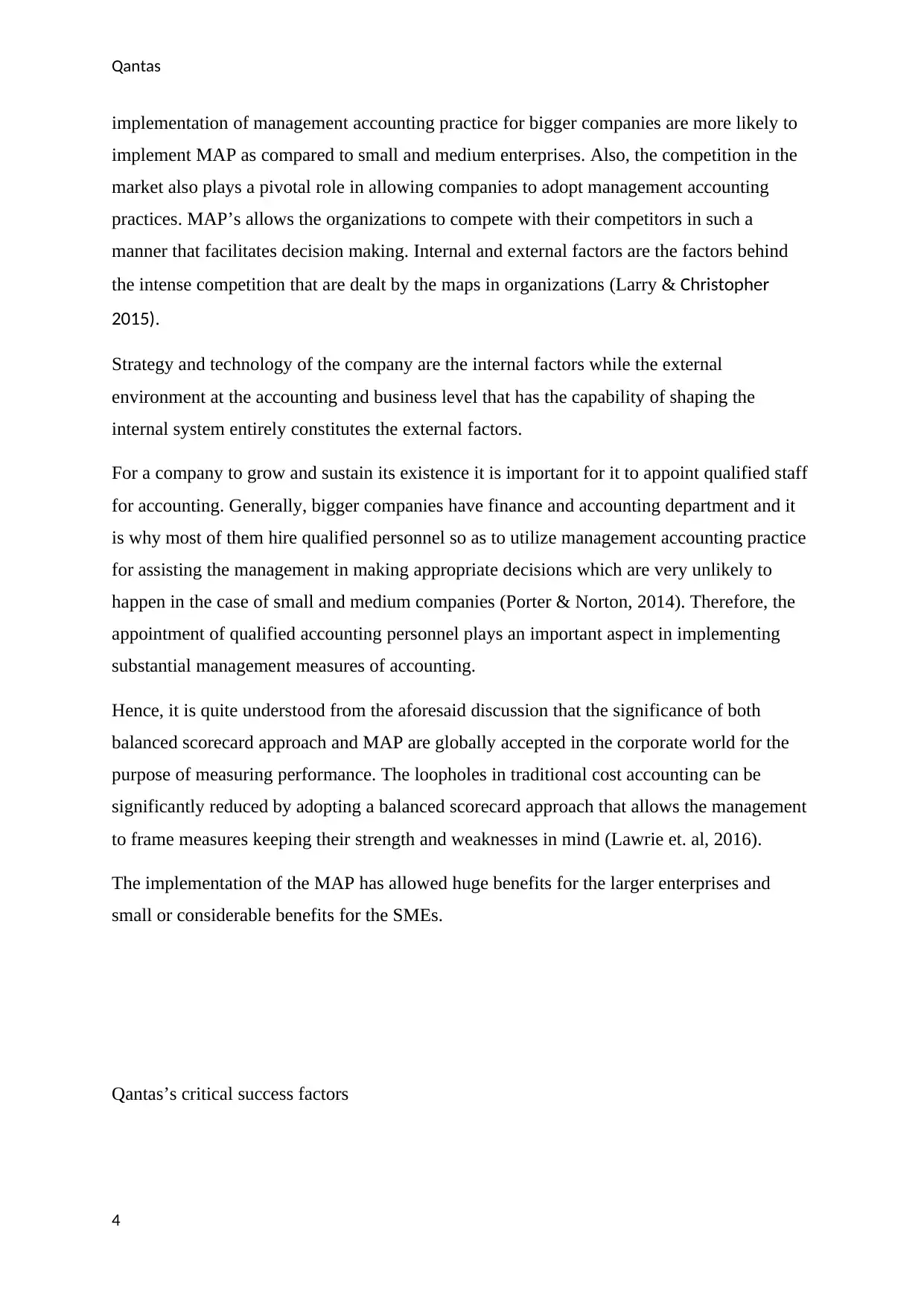
Qantas
implementation of management accounting practice for bigger companies are more likely to
implement MAP as compared to small and medium enterprises. Also, the competition in the
market also plays a pivotal role in allowing companies to adopt management accounting
practices. MAP’s allows the organizations to compete with their competitors in such a
manner that facilitates decision making. Internal and external factors are the factors behind
the intense competition that are dealt by the maps in organizations (Larry & Christopher
2015).
Strategy and technology of the company are the internal factors while the external
environment at the accounting and business level that has the capability of shaping the
internal system entirely constitutes the external factors.
For a company to grow and sustain its existence it is important for it to appoint qualified staff
for accounting. Generally, bigger companies have finance and accounting department and it
is why most of them hire qualified personnel so as to utilize management accounting practice
for assisting the management in making appropriate decisions which are very unlikely to
happen in the case of small and medium companies (Porter & Norton, 2014). Therefore, the
appointment of qualified accounting personnel plays an important aspect in implementing
substantial management measures of accounting.
Hence, it is quite understood from the aforesaid discussion that the significance of both
balanced scorecard approach and MAP are globally accepted in the corporate world for the
purpose of measuring performance. The loopholes in traditional cost accounting can be
significantly reduced by adopting a balanced scorecard approach that allows the management
to frame measures keeping their strength and weaknesses in mind (Lawrie et. al, 2016).
The implementation of the MAP has allowed huge benefits for the larger enterprises and
small or considerable benefits for the SMEs.
Qantas’s critical success factors
4
implementation of management accounting practice for bigger companies are more likely to
implement MAP as compared to small and medium enterprises. Also, the competition in the
market also plays a pivotal role in allowing companies to adopt management accounting
practices. MAP’s allows the organizations to compete with their competitors in such a
manner that facilitates decision making. Internal and external factors are the factors behind
the intense competition that are dealt by the maps in organizations (Larry & Christopher
2015).
Strategy and technology of the company are the internal factors while the external
environment at the accounting and business level that has the capability of shaping the
internal system entirely constitutes the external factors.
For a company to grow and sustain its existence it is important for it to appoint qualified staff
for accounting. Generally, bigger companies have finance and accounting department and it
is why most of them hire qualified personnel so as to utilize management accounting practice
for assisting the management in making appropriate decisions which are very unlikely to
happen in the case of small and medium companies (Porter & Norton, 2014). Therefore, the
appointment of qualified accounting personnel plays an important aspect in implementing
substantial management measures of accounting.
Hence, it is quite understood from the aforesaid discussion that the significance of both
balanced scorecard approach and MAP are globally accepted in the corporate world for the
purpose of measuring performance. The loopholes in traditional cost accounting can be
significantly reduced by adopting a balanced scorecard approach that allows the management
to frame measures keeping their strength and weaknesses in mind (Lawrie et. al, 2016).
The implementation of the MAP has allowed huge benefits for the larger enterprises and
small or considerable benefits for the SMEs.
Qantas’s critical success factors
4
Paraphrase This Document
Need a fresh take? Get an instant paraphrase of this document with our AI Paraphraser
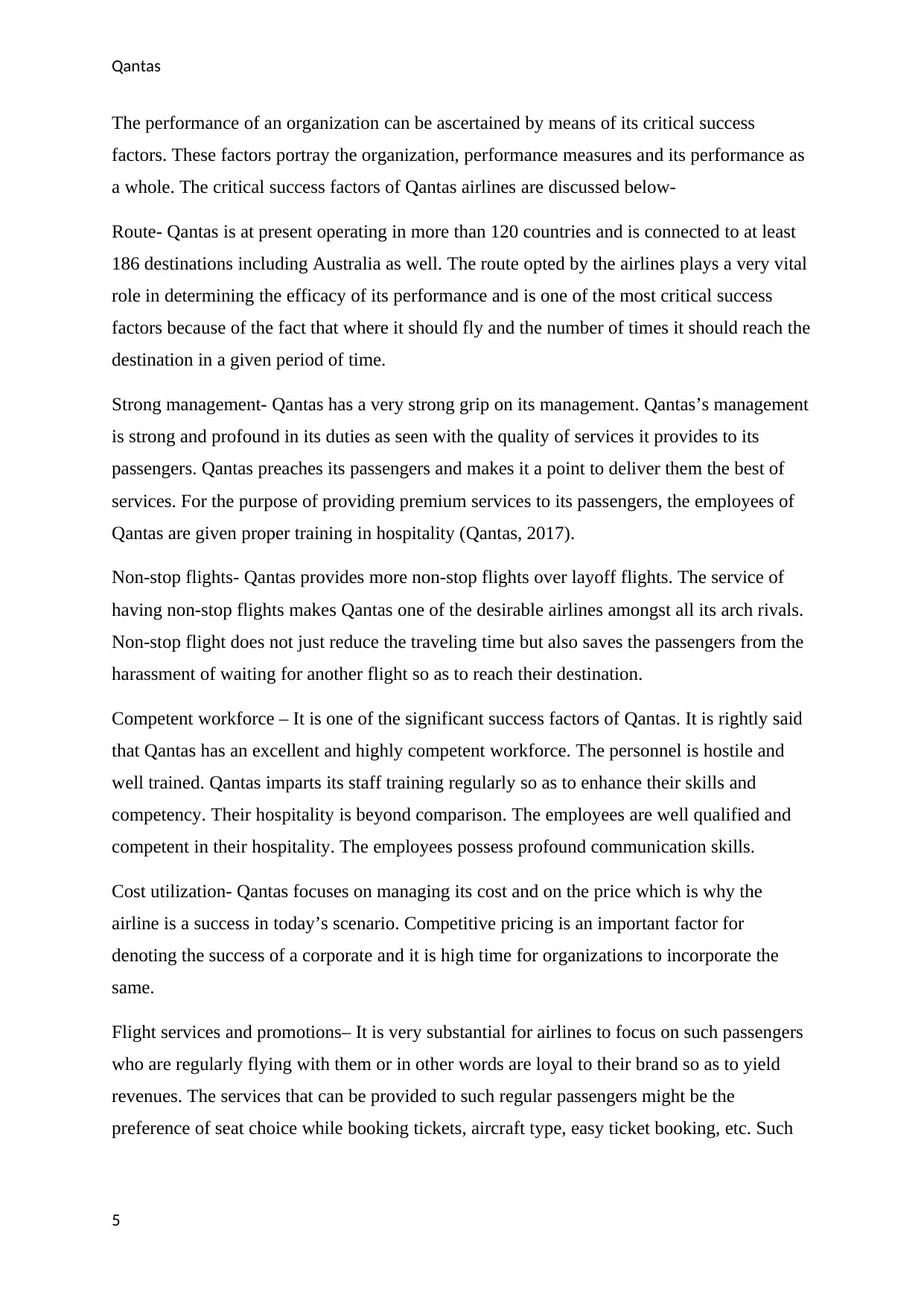
Qantas
The performance of an organization can be ascertained by means of its critical success
factors. These factors portray the organization, performance measures and its performance as
a whole. The critical success factors of Qantas airlines are discussed below-
Route- Qantas is at present operating in more than 120 countries and is connected to at least
186 destinations including Australia as well. The route opted by the airlines plays a very vital
role in determining the efficacy of its performance and is one of the most critical success
factors because of the fact that where it should fly and the number of times it should reach the
destination in a given period of time.
Strong management- Qantas has a very strong grip on its management. Qantas’s management
is strong and profound in its duties as seen with the quality of services it provides to its
passengers. Qantas preaches its passengers and makes it a point to deliver them the best of
services. For the purpose of providing premium services to its passengers, the employees of
Qantas are given proper training in hospitality (Qantas, 2017).
Non-stop flights- Qantas provides more non-stop flights over layoff flights. The service of
having non-stop flights makes Qantas one of the desirable airlines amongst all its arch rivals.
Non-stop flight does not just reduce the traveling time but also saves the passengers from the
harassment of waiting for another flight so as to reach their destination.
Competent workforce – It is one of the significant success factors of Qantas. It is rightly said
that Qantas has an excellent and highly competent workforce. The personnel is hostile and
well trained. Qantas imparts its staff training regularly so as to enhance their skills and
competency. Their hospitality is beyond comparison. The employees are well qualified and
competent in their hospitality. The employees possess profound communication skills.
Cost utilization- Qantas focuses on managing its cost and on the price which is why the
airline is a success in today’s scenario. Competitive pricing is an important factor for
denoting the success of a corporate and it is high time for organizations to incorporate the
same.
Flight services and promotions– It is very substantial for airlines to focus on such passengers
who are regularly flying with them or in other words are loyal to their brand so as to yield
revenues. The services that can be provided to such regular passengers might be the
preference of seat choice while booking tickets, aircraft type, easy ticket booking, etc. Such
5
The performance of an organization can be ascertained by means of its critical success
factors. These factors portray the organization, performance measures and its performance as
a whole. The critical success factors of Qantas airlines are discussed below-
Route- Qantas is at present operating in more than 120 countries and is connected to at least
186 destinations including Australia as well. The route opted by the airlines plays a very vital
role in determining the efficacy of its performance and is one of the most critical success
factors because of the fact that where it should fly and the number of times it should reach the
destination in a given period of time.
Strong management- Qantas has a very strong grip on its management. Qantas’s management
is strong and profound in its duties as seen with the quality of services it provides to its
passengers. Qantas preaches its passengers and makes it a point to deliver them the best of
services. For the purpose of providing premium services to its passengers, the employees of
Qantas are given proper training in hospitality (Qantas, 2017).
Non-stop flights- Qantas provides more non-stop flights over layoff flights. The service of
having non-stop flights makes Qantas one of the desirable airlines amongst all its arch rivals.
Non-stop flight does not just reduce the traveling time but also saves the passengers from the
harassment of waiting for another flight so as to reach their destination.
Competent workforce – It is one of the significant success factors of Qantas. It is rightly said
that Qantas has an excellent and highly competent workforce. The personnel is hostile and
well trained. Qantas imparts its staff training regularly so as to enhance their skills and
competency. Their hospitality is beyond comparison. The employees are well qualified and
competent in their hospitality. The employees possess profound communication skills.
Cost utilization- Qantas focuses on managing its cost and on the price which is why the
airline is a success in today’s scenario. Competitive pricing is an important factor for
denoting the success of a corporate and it is high time for organizations to incorporate the
same.
Flight services and promotions– It is very substantial for airlines to focus on such passengers
who are regularly flying with them or in other words are loyal to their brand so as to yield
revenues. The services that can be provided to such regular passengers might be the
preference of seat choice while booking tickets, aircraft type, easy ticket booking, etc. Such
5
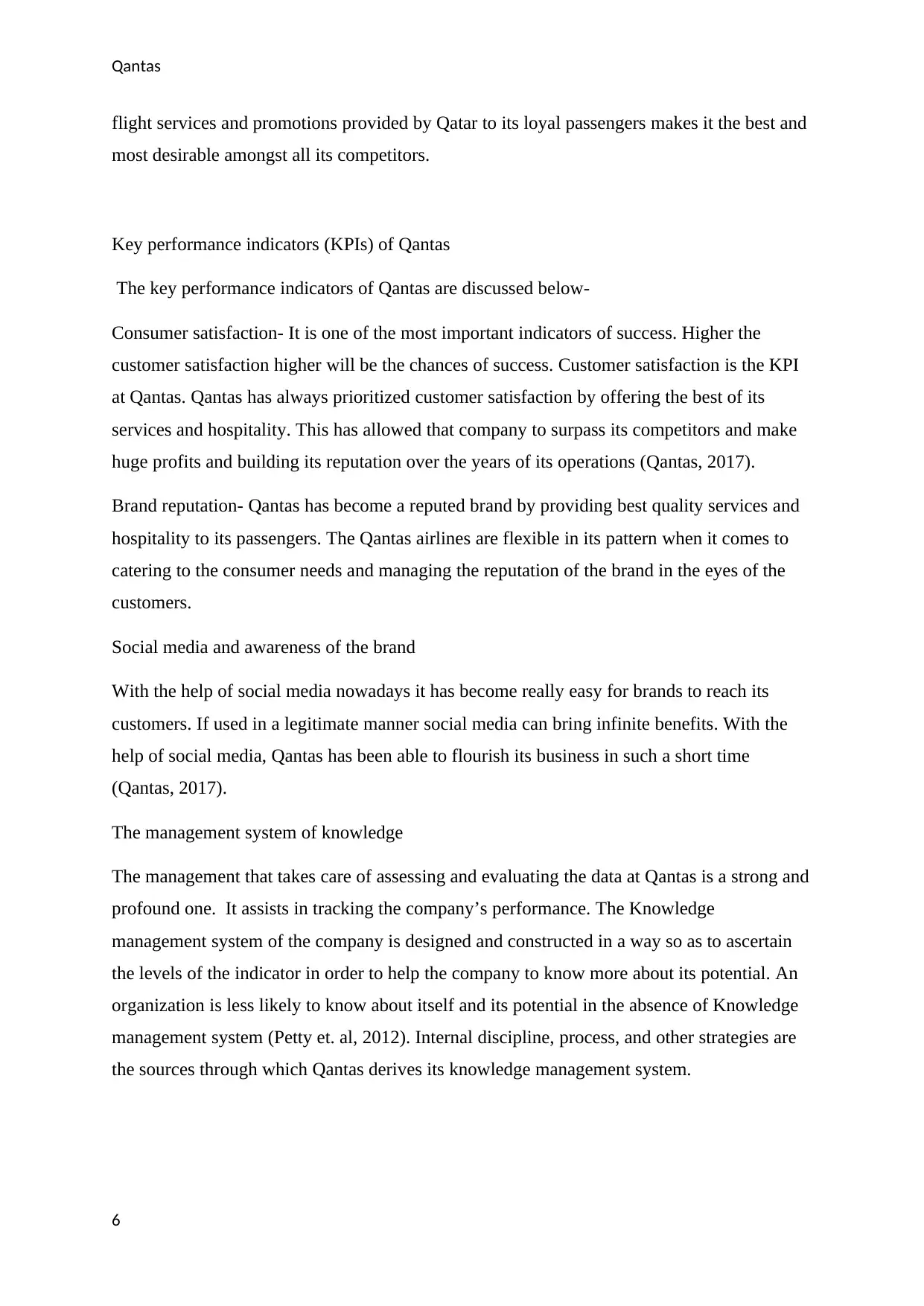
Qantas
flight services and promotions provided by Qatar to its loyal passengers makes it the best and
most desirable amongst all its competitors.
Key performance indicators (KPIs) of Qantas
The key performance indicators of Qantas are discussed below-
Consumer satisfaction- It is one of the most important indicators of success. Higher the
customer satisfaction higher will be the chances of success. Customer satisfaction is the KPI
at Qantas. Qantas has always prioritized customer satisfaction by offering the best of its
services and hospitality. This has allowed that company to surpass its competitors and make
huge profits and building its reputation over the years of its operations (Qantas, 2017).
Brand reputation- Qantas has become a reputed brand by providing best quality services and
hospitality to its passengers. The Qantas airlines are flexible in its pattern when it comes to
catering to the consumer needs and managing the reputation of the brand in the eyes of the
customers.
Social media and awareness of the brand
With the help of social media nowadays it has become really easy for brands to reach its
customers. If used in a legitimate manner social media can bring infinite benefits. With the
help of social media, Qantas has been able to flourish its business in such a short time
(Qantas, 2017).
The management system of knowledge
The management that takes care of assessing and evaluating the data at Qantas is a strong and
profound one. It assists in tracking the company’s performance. The Knowledge
management system of the company is designed and constructed in a way so as to ascertain
the levels of the indicator in order to help the company to know more about its potential. An
organization is less likely to know about itself and its potential in the absence of Knowledge
management system (Petty et. al, 2012). Internal discipline, process, and other strategies are
the sources through which Qantas derives its knowledge management system.
6
flight services and promotions provided by Qatar to its loyal passengers makes it the best and
most desirable amongst all its competitors.
Key performance indicators (KPIs) of Qantas
The key performance indicators of Qantas are discussed below-
Consumer satisfaction- It is one of the most important indicators of success. Higher the
customer satisfaction higher will be the chances of success. Customer satisfaction is the KPI
at Qantas. Qantas has always prioritized customer satisfaction by offering the best of its
services and hospitality. This has allowed that company to surpass its competitors and make
huge profits and building its reputation over the years of its operations (Qantas, 2017).
Brand reputation- Qantas has become a reputed brand by providing best quality services and
hospitality to its passengers. The Qantas airlines are flexible in its pattern when it comes to
catering to the consumer needs and managing the reputation of the brand in the eyes of the
customers.
Social media and awareness of the brand
With the help of social media nowadays it has become really easy for brands to reach its
customers. If used in a legitimate manner social media can bring infinite benefits. With the
help of social media, Qantas has been able to flourish its business in such a short time
(Qantas, 2017).
The management system of knowledge
The management that takes care of assessing and evaluating the data at Qantas is a strong and
profound one. It assists in tracking the company’s performance. The Knowledge
management system of the company is designed and constructed in a way so as to ascertain
the levels of the indicator in order to help the company to know more about its potential. An
organization is less likely to know about itself and its potential in the absence of Knowledge
management system (Petty et. al, 2012). Internal discipline, process, and other strategies are
the sources through which Qantas derives its knowledge management system.
6
⊘ This is a preview!⊘
Do you want full access?
Subscribe today to unlock all pages.

Trusted by 1+ million students worldwide
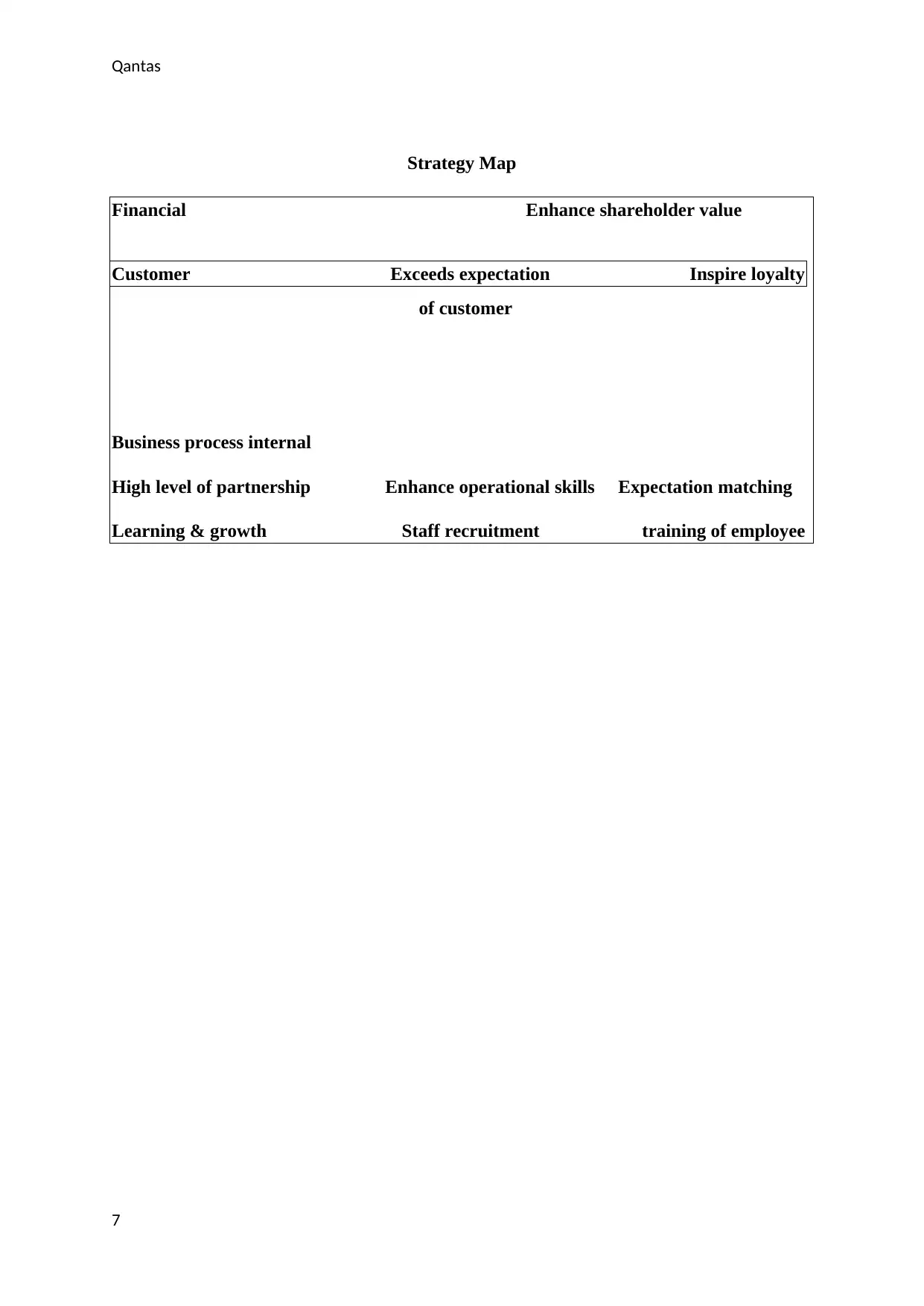
Qantas
Strategy Map
Financial Enhance shareholder value
of customer
Business process internal
High level of partnership Enhance operational skills Expectation matching
Learning & growth Staff recruitment training of employee
7
Customer Exceeds expectation Inspire loyalty
Strategy Map
Financial Enhance shareholder value
of customer
Business process internal
High level of partnership Enhance operational skills Expectation matching
Learning & growth Staff recruitment training of employee
7
Customer Exceeds expectation Inspire loyalty
Paraphrase This Document
Need a fresh take? Get an instant paraphrase of this document with our AI Paraphraser
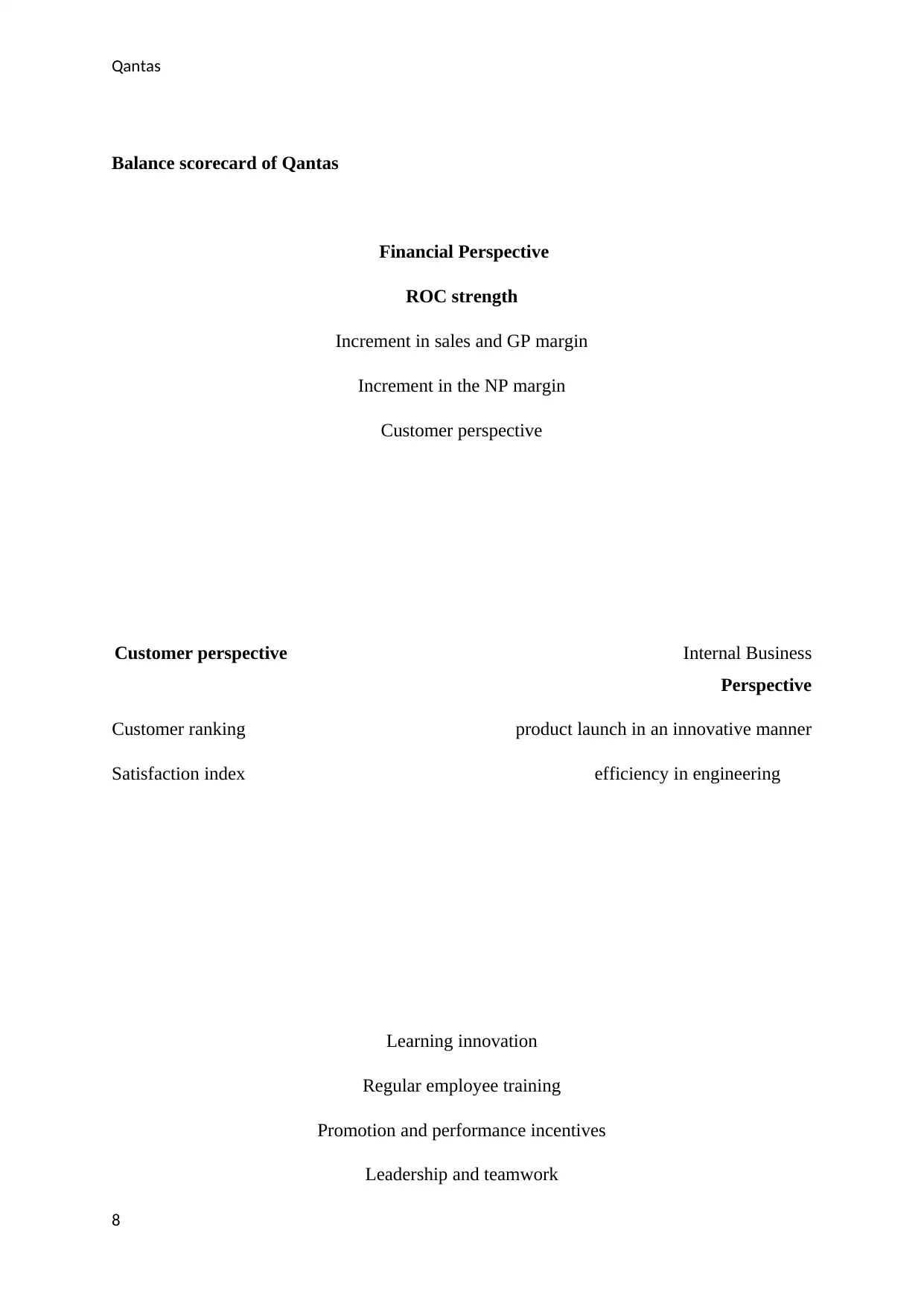
Qantas
Balance scorecard of Qantas
Financial Perspective
ROC strength
Increment in sales and GP margin
Increment in the NP margin
Customer perspective
Customer perspective Internal Business
Perspective
Customer ranking product launch in an innovative manner
Satisfaction index efficiency in engineering
Learning innovation
Regular employee training
Promotion and performance incentives
Leadership and teamwork
8
Balance scorecard of Qantas
Financial Perspective
ROC strength
Increment in sales and GP margin
Increment in the NP margin
Customer perspective
Customer perspective Internal Business
Perspective
Customer ranking product launch in an innovative manner
Satisfaction index efficiency in engineering
Learning innovation
Regular employee training
Promotion and performance incentives
Leadership and teamwork
8
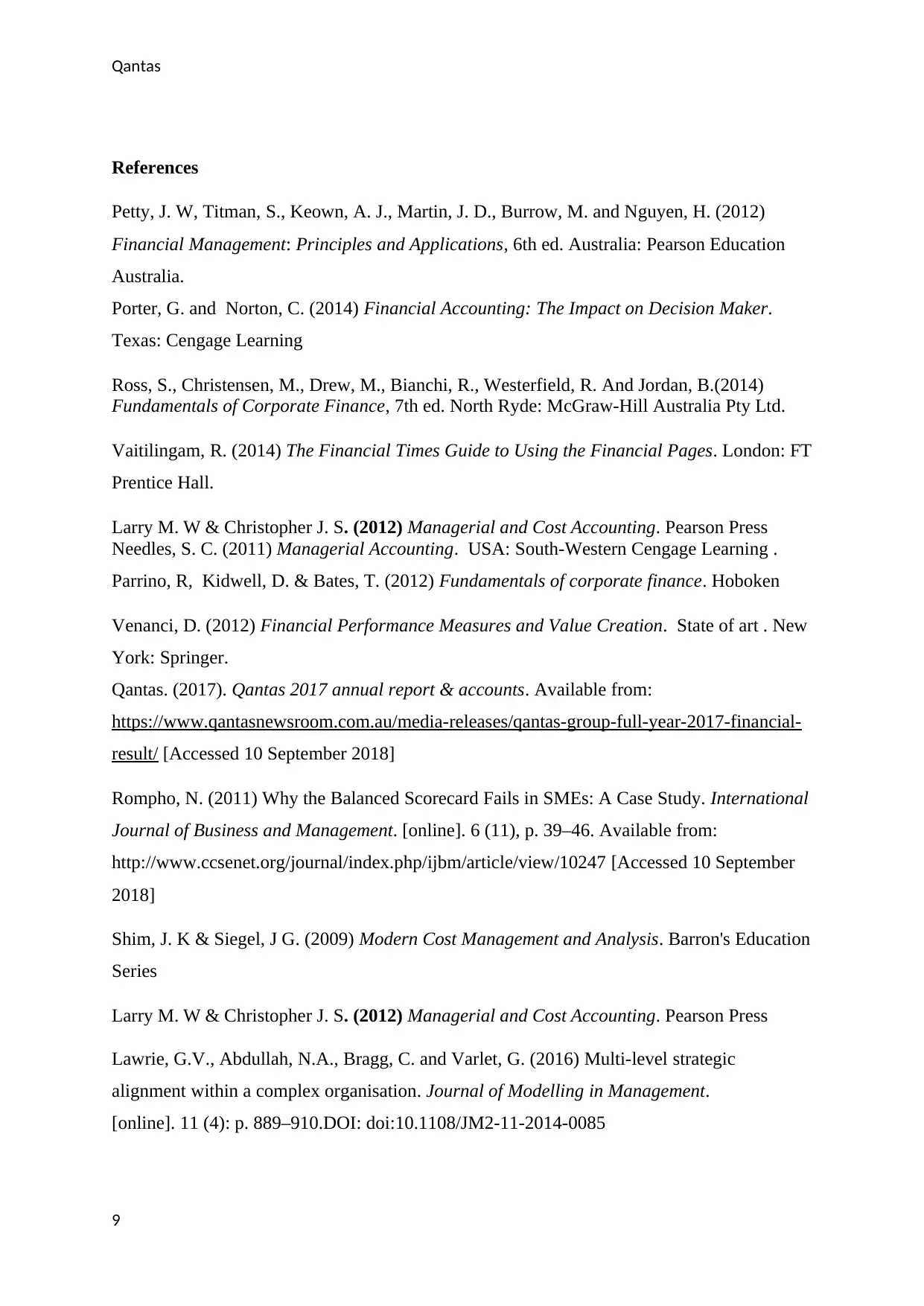
Qantas
References
Petty, J. W, Titman, S., Keown, A. J., Martin, J. D., Burrow, M. and Nguyen, H. (2012)
Financial Management: Principles and Applications, 6th ed. Australia: Pearson Education
Australia.
Porter, G. and Norton, C. (2014) Financial Accounting: The Impact on Decision Maker.
Texas: Cengage Learning
Ross, S., Christensen, M., Drew, M., Bianchi, R., Westerfield, R. And Jordan, B.(2014)
Fundamentals of Corporate Finance, 7th ed. North Ryde: McGraw-Hill Australia Pty Ltd.
Vaitilingam, R. (2014) The Financial Times Guide to Using the Financial Pages. London: FT
Prentice Hall.
Larry M. W & Christopher J. S. (2012) Managerial and Cost Accounting. Pearson Press
Needles, S. C. (2011) Managerial Accounting. USA: South-Western Cengage Learning .
Parrino, R, Kidwell, D. & Bates, T. (2012) Fundamentals of corporate finance. Hoboken
Venanci, D. (2012) Financial Performance Measures and Value Creation. State of art . New
York: Springer.
Qantas. (2017). Qantas 2017 annual report & accounts. Available from:
https://www.qantasnewsroom.com.au/media-releases/qantas-group-full-year-2017-financial-
result/ [Accessed 10 September 2018]
Rompho, N. (2011) Why the Balanced Scorecard Fails in SMEs: A Case Study. International
Journal of Business and Management. [online]. 6 (11), p. 39–46. Available from:
http://www.ccsenet.org/journal/index.php/ijbm/article/view/10247 [Accessed 10 September
2018]
Shim, J. K & Siegel, J G. (2009) Modern Cost Management and Analysis. Barron's Education
Series
Larry M. W & Christopher J. S. (2012) Managerial and Cost Accounting. Pearson Press
Lawrie, G.V., Abdullah, N.A., Bragg, C. and Varlet, G. (2016) Multi-level strategic
alignment within a complex organisation. Journal of Modelling in Management.
[online]. 11 (4): p. 889–910.DOI: doi:10.1108/JM2-11-2014-0085
9
References
Petty, J. W, Titman, S., Keown, A. J., Martin, J. D., Burrow, M. and Nguyen, H. (2012)
Financial Management: Principles and Applications, 6th ed. Australia: Pearson Education
Australia.
Porter, G. and Norton, C. (2014) Financial Accounting: The Impact on Decision Maker.
Texas: Cengage Learning
Ross, S., Christensen, M., Drew, M., Bianchi, R., Westerfield, R. And Jordan, B.(2014)
Fundamentals of Corporate Finance, 7th ed. North Ryde: McGraw-Hill Australia Pty Ltd.
Vaitilingam, R. (2014) The Financial Times Guide to Using the Financial Pages. London: FT
Prentice Hall.
Larry M. W & Christopher J. S. (2012) Managerial and Cost Accounting. Pearson Press
Needles, S. C. (2011) Managerial Accounting. USA: South-Western Cengage Learning .
Parrino, R, Kidwell, D. & Bates, T. (2012) Fundamentals of corporate finance. Hoboken
Venanci, D. (2012) Financial Performance Measures and Value Creation. State of art . New
York: Springer.
Qantas. (2017). Qantas 2017 annual report & accounts. Available from:
https://www.qantasnewsroom.com.au/media-releases/qantas-group-full-year-2017-financial-
result/ [Accessed 10 September 2018]
Rompho, N. (2011) Why the Balanced Scorecard Fails in SMEs: A Case Study. International
Journal of Business and Management. [online]. 6 (11), p. 39–46. Available from:
http://www.ccsenet.org/journal/index.php/ijbm/article/view/10247 [Accessed 10 September
2018]
Shim, J. K & Siegel, J G. (2009) Modern Cost Management and Analysis. Barron's Education
Series
Larry M. W & Christopher J. S. (2012) Managerial and Cost Accounting. Pearson Press
Lawrie, G.V., Abdullah, N.A., Bragg, C. and Varlet, G. (2016) Multi-level strategic
alignment within a complex organisation. Journal of Modelling in Management.
[online]. 11 (4): p. 889–910.DOI: doi:10.1108/JM2-11-2014-0085
9
⊘ This is a preview!⊘
Do you want full access?
Subscribe today to unlock all pages.

Trusted by 1+ million students worldwide

Qantas
10
10
1 out of 10
Related Documents
Your All-in-One AI-Powered Toolkit for Academic Success.
+13062052269
info@desklib.com
Available 24*7 on WhatsApp / Email
![[object Object]](/_next/static/media/star-bottom.7253800d.svg)
Unlock your academic potential
Copyright © 2020–2025 A2Z Services. All Rights Reserved. Developed and managed by ZUCOL.





